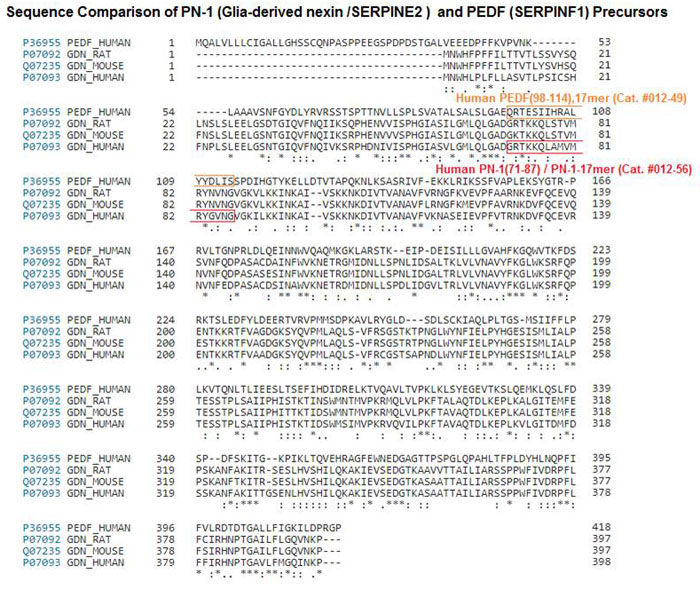Catalog # |
Size |
Price |
|
|---|---|---|---|
| 012-56 | 100 µg | $154 |
 )
)
|
Gly-Arg-Thr-Lys-Lys-Gln-Leu-Ala-Met-Val-Met-Arg-Tyr-Gly-Val-Asn-Gly
|
| 1909.29 | |
|
| ≥ 95% |
|
| Exhibits correct molecular weight |
|
| Soluble in water |
|
|
Up to 6 months in lyophilized form at 0-5ºC. For best results, rehydrate just before use. After rehydration, keep solution at +4ºC for up to 5 days or freeze at -20ºC for up to 3 months. Aliquot before freezing to avoid repeated freeze-thaw cycles. |
|
| White powder |
|
| Each vial contains 100 μg of NET peptide. |

In a prior study through a proteomic approach, we showed that protease nexin-1 (PN-1) is susceptible to MMP-9-mediated degradation in the prostate cancer microenvironment. PN-1, a 43 kDa serine protease inhibitor, prevents several key micro-environmental proteases including urokinase plasminogen activator (uPA, encoded by PLAU), tissue plasminogen activator (tPA), thrombin, and plasmin. High levels of MMP-9 and uPA are associated with disease progression and an unfavorable prognosis in several human solid cancers. Although deregulation of PN-1 occurs in several solid cancers, the role if any, of PN-1 in hematological cancers is unknown. The coincidence of MMP9 and PLAU gene found in the DLBCL stromal 1 signature5 suggests a possible link between expression of these genes and the lymphoma microenvironment.
Xin X, Ding Y, Yang Y, et al. Protease nexin-1 prevents growth of human B cell lymphoma via inhibition of sonic hedgehog signaling. Blood Cancer J. 2018;8(2):24.
PURPOSE: Protease nexin-1 (PN-1), a serpin encoded by the SERPINE2 gene, has serine protease inhibitory activity and neurotrophic properties in the brain. PN-1 inhibits retinal angiogenesis; however, PN-1's neurotrophic capacities in the retina have not yet been evaluated. Pigment epithelium-derived factor (PEDF) is a serpin that exhibits neurotrophic and antiangiogenic activities but lacks protease inhibitory properties. The aim of this study is to compare PN-1 and PEDF.METHODS: Sequence comparisons were performed using computer bioinformatics programs. Mouse and bovine eyes, human retina tissue, and ARPE-19 cells were used to prepare RNA and protein samples. Interphotoreceptor matrix lavage was obtained from bovine eyes. Gene expression and protein levels were evaluated with reverse-transcription PCR (RT-PCR) and western blotting, respectively. Recombinant human PN-1, a version of PN-1 referred to as PN-1[R346A] lacking serine protease inhibitory activity, and PEDF proteins were used, as well as synthetic peptides designed from PEDF and PN-1 sequences. Survival activity in serum-starved, rat-derived retinal precursor (R28) cells was assessed with terminal deoxynucleotidyl transferase (TdT) dUTP nick-end labeling (TUNEL) cell death assays. Bcl2 levels were measured with RT-PCR.RESULTS: PN-1 is analogous in primary and tertiary structure to PEDF. A region in PN-1 shares homology with the neurotrophic active region of PEDF, a 17-residue region within alpha helix C. The native human retina, ARPE-19 cells, and murine RPE and retina expressed the gene for PN-1 (SERPINE2 and Serpine2 mRNA). The retina, ARPE-19 cell lysates, and bovine interphotoreceptor matrix contained PN-1 protein. The addition of PN-1, PN-1[R346A], or the 17mer peptide of PN-1 to serum-starved retina cells decreased the number of TUNEL-positive nuclei relative to the untreated cells, such as PEDF. PN-1, PN-1[R346A], and PN-1-17mer treatments increased the Bcl2 transcript levels in serum-starved cells, as seen with PEDF.CONCLUSIONS: PN-1 and PEDF share structural and functional features, and expression patterns in the retina. These serpins' mechanisms of action as cell survival factors are independent of serine protease.
Winokur PN, Subramanian P, Bullock JL, Arocas V, Becerra SP. Comparison of two neurotrophic serpins reveals a small fragment with cell survival activity. Mol Vis. 2017;23:372-384.
No References
| Catalog# | Product | Size | Price | Buy Now |
|---|
Social Network Confirmation